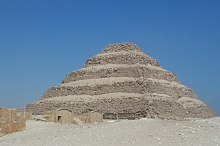Layer pyramid
The transition from the mastaba as the burial place of the kings of the first and second dynasties to the shape of the pyramid took place under Djoser : starting from a mastaba made of small-format stones, which was expanded several times, was created by adding several inwards at an angle of 72 ° inclined layers with a thickness of 5 cubits each, the height of which increased from the outside in, the first pyramid ( Djoser pyramid ). Externally, the different heights of the layers can be recognized as steps, which has often led to the incorrect designation " step pyramid " in the literature .
Lauer has researched the pyramid of Djoser in detail and determined the various construction phases as well as the building structure and the number of layers with 11.
The unfinished pyramids of the Sechemchet ( Sechemchet pyramid ) and the Chaba ( Chaba pyramid ), the various small pyramids, probably from the reign of the Huni in Edfu-Süd , El-Kula , Ombos , Saujet el-Meitin , Seila , Sinki and Elephantine , are also all built according to the principle of a layer pyramid: layers of stone with inwardly inclined stone layers were added around an inner core.
Sneferu had his first pyramid in Meidum Meidum-Pyramid also built in layers. It was created in several construction phases. The layer thickness has been doubled to 10 cubits. The cult pyramid in Meidum was also built in this way. The pyramid was later given a horizontally laid outer cladding, which for the first time gave the structure the shape of a "real" pyramid.
In general, the inclined arrangement of the stone layers leads to an increased pressure (weight component) diagonally outwards. At an angle of approx. 70 ° this is 30% of the total weight of the layer. When the subsoil subsided (instability, excessive ground pressure from the structure) and as a result of earthquakes, which also occurred frequently in the Old Kingdom and which in some cases led to severe damage, various layer pyramids caused faults and shifts in individual layers. In 2005 the Egyptian National Research Institute for Astronomy and Geophysics pointed out in a newly compiled catalog of earthquakes in the Nile Valley between the years 2200 BC. And 2004 AD, point out.
After settlement and structural damage occurred during the construction of the bent pyramid in Dahshur South, which was at times simultaneous with the Meidum Pyramid , it was at this point in time at the latest that the master builders realized that a different construction method had to be developed and used for the pyramid construction for reasons of stability. A change in the laying of the stones (horizontally instead of inclined inwards) has already been applied in the upper half of the bent pyramid.
The construction methods of the subsequent pyramids, the Red Pyramid and the Cheops Pyramid , were successively changed: The principle of horizontal stone laying and a stepped core masonry was used from then until the end of the 6th Dynasty.
literature
- Mark Lehner: Mystery of the Pyramids , Orbis, Munich 1999, ISBN 3-572-01039-X .
- Frank Müller-Römer : The construction of the pyramids in ancient Egypt , Utz, Munich 2011, ISBN 978-3-8316-4069-0 .
- Rainer Stadelmann : The Egyptian pyramids. From brick construction to the wonder of the world (= cultural history of the ancient world . Volume 30). 3rd, updated and expanded edition. Philipp von Zabern, Mainz 1997, ISBN 3-8053-1142-7 .
Individual evidence
- ^ R. Stadelmann: Die ägyptischen Pyramiden , von Zabern, Mainz 1997, p. 51, ISBN 3-8053-1142-7
- ↑ JP Lauer: Histoire Monumentale des Pyramides d'Egypte , vol. I: Les Pyramides à Degrés , Institut Français d'Archéologie Orientale, Cairo 1962, plate 10.
- ^ MZ Goneim The Lost Pyramid , Brockhaus, Wiesbaden 1995
- ^ V. Maragioglio, CA Rinaldi, L'Architettura delle Pyramidi Menfite , Volume II, Turin / Rapallo 1963.
- ↑ G. Dreyer and W. Kaiser On the small step pyramids of Upper and Middle Egypt. In: Communications from the Cairo Archaeological Institute, Volume 36, 1980, pp. 43ff.
- ↑ F. Müller-Römer, The construction of the pyramids in ancient Egypt , Utz, Munich 2011, ISBN 978-3-8316-4069-0 , p. 150ff.
- ↑ Ludwig Borchardt : The emergence of the pyramid . Springer, Berlin 1928, plate 3.
- ^ V. Maragioglio, CA Rinald :, L'Achitettura delle Pyramidi Menfite , Volume III, Turin / Rapallo 1963, Addenda Taf. 2, 2.
- ↑ F. Müller-Römer; The construction of the pyramids in ancient Egypt , Utz, Munich 2011, ISBN 978-3-8316-4069-0 , p. 225ff.
- ↑ Seismicity of Egypt , GeoScienceWorld
- ↑ R. Winkler: Logistics of the pyramid construction . Dissertation at Faculty 1, Architecture and Urban Planning, Technical University of Stuttgart, 2002
- ↑ Frank Müller-Römer, The construction of the pyramids in the Old Kingdom , Utz, Munich 2011, section 5.3, p. 225ff., ISBN 978-3-8316-4069-0

